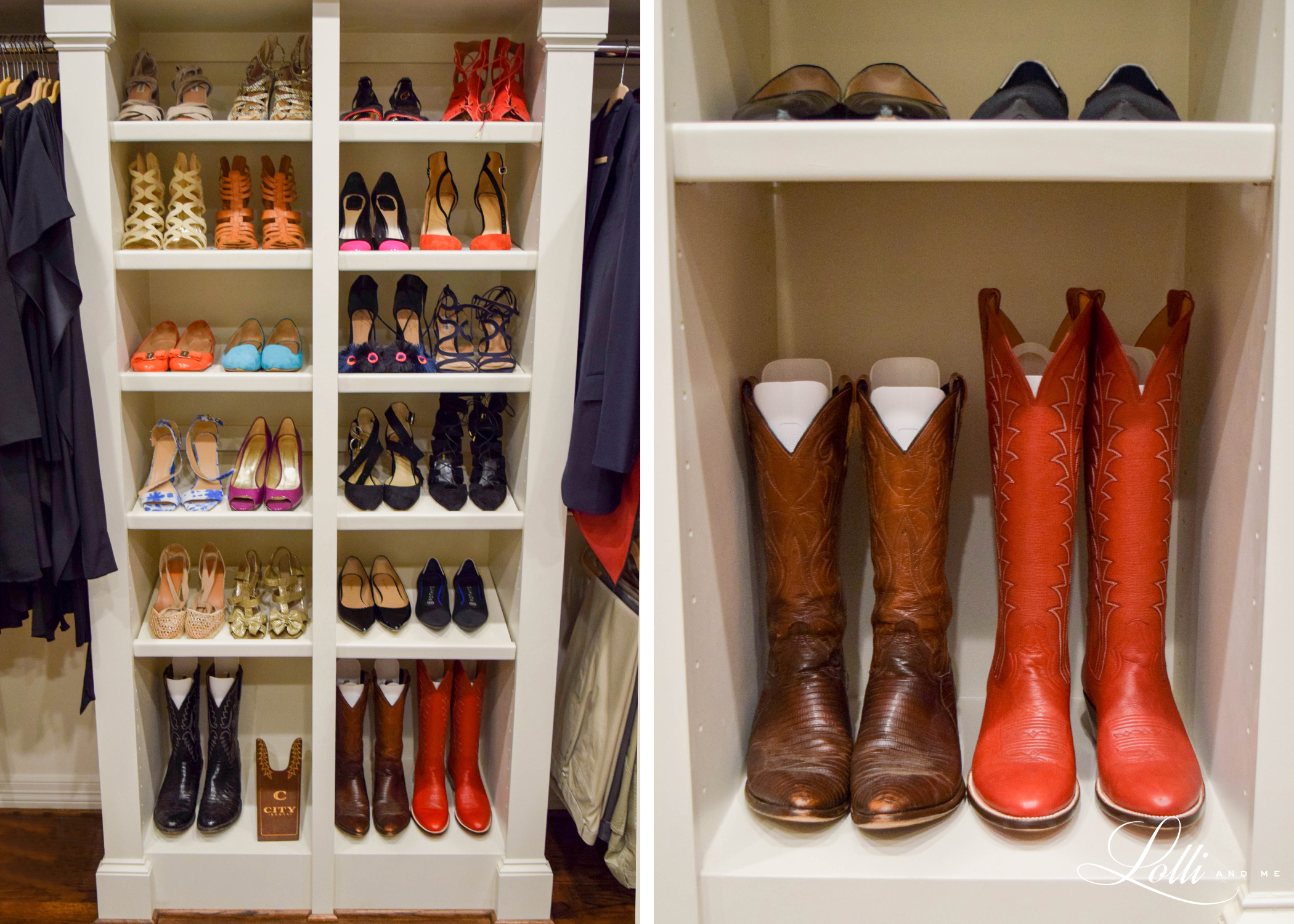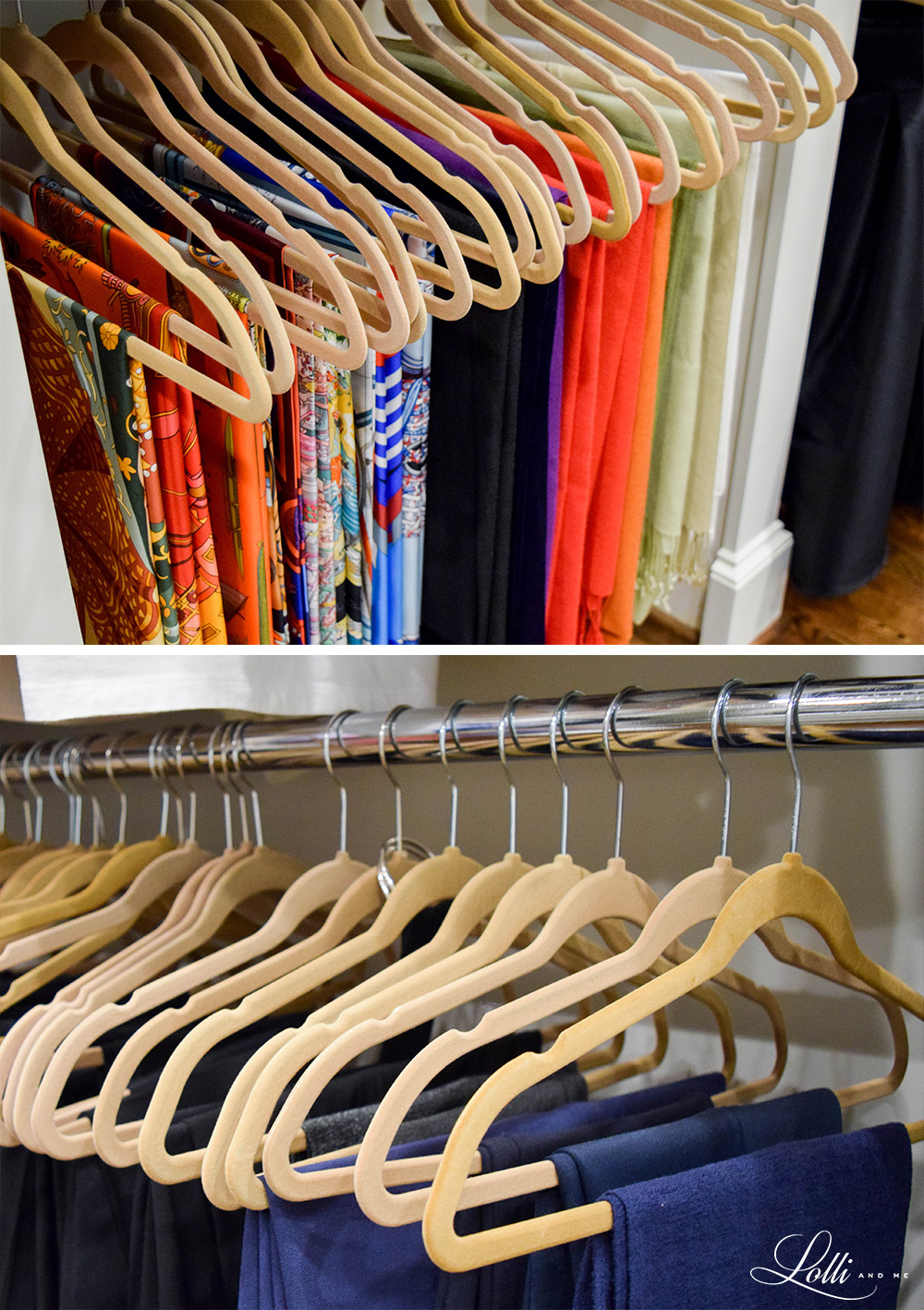Welcome to day five of our SPRING CLEANING WEEK series! Catch up on day one, day two, day three, and day four, and be sure to enter for your chance to win A GIVEAWAY A DAY this week! All of this week’s giveaways run until Friday (today!) at 5:00 PM CST. Enter any or all of the giveaways while there’s still time! Winners will be announced tomorrow, Saturday, at 10 AM CST on our Instagram stories @lolliandme!
For the last day of our series, Debby Jett Allbright, a longtime friend, professional model, and owner of Fashionomics, is sharing her tips on closet organization! Debby helped me systemize the master closet when we moved into our new home over a year ago and then recently came by a few weeks ago to help me switch out my closet from winter to spring (more on that later in the post!). Debby has been a professional closet organizer for more than 12 years, and she’s developed a system that I’ve personally found to be effective and that works for her spectrum of clients. Today, we’re sharing some of Debby’s tips to help get you started on your own closet organization process (P.S. This photo was my closet’s “BEFORE”):
“I think it is common for a woman to stand in her closet and say ‘I have nothing to wear!’ In my opinion – less is more – which is the theory behind Fashionomics: The Art of Systemizing your Wardrobe. ‘So many clothes but nothing to wear’ is a result of having too many things in your closet. My goal is to create efficient wardrobes with many options from fewer pieces. More order and less clutter bring a calm and peace to your life so that you feel pretty and confident as you go about your day.” – Debby
Tip 1: EDIT & PURGE
When I work with a client, our first step is to analyze the current state of his/her closet. This is a process that takes a bit of time because we literally go through each piece, sorting items into four categories: keep, alter, consign, or donate. When going through your own closet, some questions to ask are:
- Have you worn it in the last 2 years?
- Will you wear it again? Do you like it? Be honest with yourself.
- Does it fit? Is it flattering? Is is on trend or out of style? I don’t get rid of classic pieces that never go out of style as long as they fit.
- Does it need alterations? Alterations need to be included in your clothing budget. Very important!!
- Can it go to resale? It needs to be in great condition and currently in style. If it’s not a consignment piece, then it can be donated for someone else to enjoy.
And remember – just because someone gave it to you, doesn’t mean you have to keep it. Also, if something is an heirloom piece (like a wedding gown or your grandmother’s fur coat), it can be stored separately from your main closet area. I recommend keeping your master closet full of what you actually wear and what is seasonally relevant.
Tip 2: SORT & ORGANIZE
After editing, organizing your closet is the next step to bringing order to your wardrobe and your life. You want to be able to see your things, get dressed without stress, and feel peaceful when you walk into or out of your closet.
Once you have edited you wardrobe down to the pieces that you love, ones that fit and that will work for you, you can start to sort and organize. I start by hanging like pieces together: skirts, pants, tops and blouses, jackets, dresses, cocktail and evening. (I always recommend Joy Huggable Hangers in the same color. Your clothes will keep their shape and won’t fall off. It is worth the investment!) I arrange each group in color order from light to dark or dark to light, depending on the lighting in your closet. Which brings me to another very important subject – LIGHTING! I like to say that if I can’t tell black from navy then you do not have proper lighting in your closet. I do have some practical solutions for lighting that are not too expensive.
As for organizing your shoes, that really depends on the set up of your closet. You can use shelves, plastic shoe boxes and/or hanging solutions. One rule is to get your shoes out of the original boxes and into clear boxes so you can easily see what you have. I want every thing to look as uniform as possible, and I also try to get everything off the floor!
Tip 3: MIX & MATCH
Sometimes I have the luxury of displaying beautiful handbags as in a boutique setting. I just have to get into your closet and see what the possibilities are. I also like to edit and organize jewelry and figure out the best solution, whether it’s making space in a drawer or hanging in your closet or vanity area. Every project is like a puzzle to me, and I have never found a closet conundrum I couldn’t solve, no matter how large or small. I have organized closets in apartments and multiple closets in mansions. It’s always a challenge, but I am never satisfied until it looks calm, cool and collected. You just have to keep mixing and matching until the system works for that particular client. Most importantly, out with the clutter!
Tip 4: PLAN TO SHOP
Once you’ve edited and organized, you can actually identify gaps in your wardrobe and plan to shop accordingly. After a good closet refresh, you can actually see what you need (or don’t need) to shop for going forward. I have a list of wardrobe essentials I recommend to clients and will even put outfits together and/or shop for them if needed. Remember, less is more! You can get a lot of outfits out of just a few items styled different ways.
Tip 5: COMBINE & COORDINATE
Put like colors together where there are categories of clothing or shoes that seem to be of the same theme. Lots of women have a collection of white blouses, for example, or nude heels. Find a place in the closet that they can all be grouped together, which not only makes for a pretty visual but is convenient as you’re getting dressed. Efficiency is another objective of this process. You can save so much time when you know where everything is!
Tip 6: OFF-SEASON STORAGE
A couple of years ago, I did a lot of research and wrote a blog post on this very subject. The main point is that it is important that you properly store your natural fibers like wool, silk and cotton this time of year, as we are transferring our closets from fall/winter to spring/summer. I like to take care of my clothes, and winter clothes tend to be more expensive, so protect those cashmere sweaters properly. I generally go by Ken Weber’s (of Vintage Martini) “Top 10 Clothing Care Tips:”
1. Never use mothballs. The odor is impossible to remove and it will eventually spread through the house and onto your body. Hang dry lavender in your closet instead. (I recommend cedar blocks or sachets) Did you know that cedar closets need to be sanded and resprayed each season to repel bugs?
2. Do not hang your rayon and silk knits. They will stretch, and a sweater will become a dress if you wait too long.
3. We have a tendency to shop our own closets by pushing things from the hanging shoulder. The oils on our hands will eventually turn the shoulders yellow. Purchase shoulder bags to protect your whites.
4. Do not store your clothing in plastic dry cleaner bags, but try a natural cotton hanging bag. Fabrics need to breathe.
5. If you have a stack of family wedding gown boxes in storage, there’s a good chance they have now turned a buttery yellow and all the drops of champagne that were not properly seen are now dots or dark brown. Sadly, they are no longer cleanable. To properly save your wedding gown, have it professionally dry cleaned by an expert in conservation and have it packed in an acid-free box with acid-free tissue.
6. Do not pack cedar blocks with textiles. The oils in wood will stain what they are touching over time.
7. Silk is a cannibal! The acids in silk will actually eat itself over time which is called shattering. Shattering looks like a cat has shredded the fabric with its claws. Once this has started, there’s no way of saving the item whether it’s an old crazy quilt or grandma’s wedding dress. Always keep silks stored in acid-free tissue with as little of the silk touching itself as possible.
8. Do not store your clothing in the garage, storage unit or attic. Extreme temperatures can create dry rot, mold, shattering, etc. If you’ve moved it out of the closet, there’s a reason. Don’t pay for storage until it becomes unwearable. Move it along to charity or make some “fun” money on those old clothes.
9. If you have a window in your closet, make sure you have filtered blinds. Continual light will fade your fabrics.
10. Overhead fluorescent lighting is not your friend! It will fade the shoulders or your clothing faster than you can image.
I hope these tips have helped you get motivated to edit and organize your closet. I can’t give away all of my secrets today, so if you need more help, feel overwhelmed, or are crunched for time, give Fashionomics a call! XO, Debby
Shop some of Debby’s top tools for tried-and-true closet organization products here:
That wraps up our SPRING CLEANING WEEK series! In case you missed a day, the whole series is linked below:
Day 1: Kitchen & Pantry // Day 2: Children’s Spaces // Day 3: Craft Room & Storage Spaces // Day 4: Closet & Vanity
Thanks for following along! We hope this week has inspired some ideas for your own spring cleaning projects around the house. Please share your “before and afters” with us by tagging @lolliandme in any of your posts about #springcleaning!









